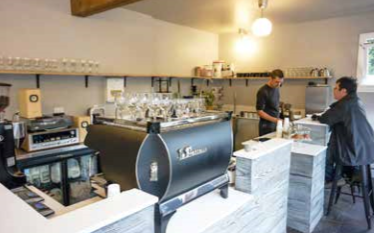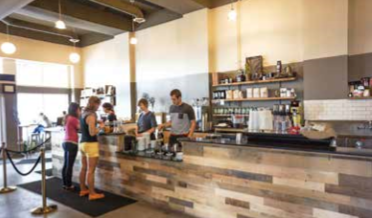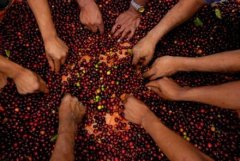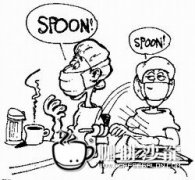The Development of Fine Coffee Culture the History of Coffee Development in Seattle
JoeMonaghan, president of laMazocco coffee America, uses his point of view to understand how Seattle's coffee culture has changed over the past decade. Joe, who was a college student in the 1970s, entered the industry through a friend who used to work for TheGoodCoffee and SeattleBestCoffee. There were only a few small coffee shops and bakers in Seattle, including, of course, Starbucks coffee.
JoeMonaghan: "the industry was originally small, but it didn't change until the late 1970s to the early 1980s." The beginning of the change should have started at the University of California, Berkeley, because coffee was so bad that students added a lot of milk to adjust the taste, which is the origin of the latte. Compared with cappuccino or concentrated coffee and latte, latte is mild and delicious. At that time, stalls selling concentrated coffee will begin to be seen on the street, even in Nordstam department stores. In the mid-1980s, Starbucks coffee began selling coffee in addition to its baking business. Another person who also had an impact on Seattle's coffee was AlfredPeet of the University of Berkeley, who was the first baker to buy high-grade coffee beans from Central America. These coffee beans are significantly different from the coffee beans that Italian bakers like to use, that is, beans from Central and South America have more acidity and deep baking is becoming more and more popular.
Many operators in Seattle have begun to buy coffee machines, coffee stalls or stalls to set up coffee stores, and people know more about coffee. Shops and coffee cars became very popular in the 1980s and mid-1990s, and many of them were very successful.
Many people from various states in the United States come to Seattle to observe this phenomenon. They copied and improved what they saw, so they began to have speed coffee (Drive-thrucoffee), gas station coffee, supermarket coffee and so on. There are several very successful people like Monorail Espresso's Chuck Beek and Espresso vivace's founder David Schomer, who are pioneers in starting the coffee car business. Another is Joe's business partner, DavidKentBakke, executive chairman of laMazocco America.
JoeMonaghan: "We don't have a coffee storefront, we only have to sell coffee machines, and we will teach people how to make coffee, how to build stalls and how to open stores. When we sold smartphones in the 1970s, there were only a few brands on the Seattle market, including laMazocco. Customers have always had a good evaluation of laMazocco, which is the reason why the brand can be successful. " Joe's success has inspired many people to follow his example. Some have succeeded, but many have failed. The growth of the industry has led to the expansion of many industries such as Starbucks, but it has also caused shortages in the supply of smartphones. When laMazocco can no longer meet the needs of the market, many other brands have taken the opportunity to enter the market. With Starbucks coffee's growing demand for machines, Joe decided to set up a local laMazocco assembly plant in Seattle. When the Seattle factory opened in 1995, about 90% of the machines were supplied to Starbucks. But when the head office decided to close the Seattle plant and move back to Italy, many old employees used what they had learned to set up new brands such as Synesso and Slayer.

Slate Coffee, another fashion boutique coffee shop in Seattle
What are the differences in coffee culture among Seattle, Chicago and Portland?
JoeMonaghan: "personally, I don't think there's much difference." There is no difference in making the best coffee for customers, whether in Portland, Osio, Italy, or in London, when it comes to making the best coffee. They all need the best equipment to accomplish this task. The language, coffee training institute, name or currency may be different, but the coffee culture is the same. "
The future of the IEEE industry?
JoeMonaghan: "I am very optimistic about the future, because coffee has become a focus in people's lives." In the past, candidates liked to talk to people in restaurants, but because of social changes, these candidates communicated with people in the coffee hall instead. The earth's climate may affect our future, but the use of coffee continues to grow so I can see a bright future for the IEEE industry.

Milstead, Seattle modern boutique coffee shop
What is the future of traditional PUBE and fully automatic PUBE?
JoeMonaghan: "sometimes I wonder at 3: 00 in the morning how long people will continue to buy Penee phones." I classify coffee stores into two categories. The first category is that, like Starbucks coffee, people who drink coffee will not care about the name of coffee division or what brand of coffee machine they use, because they only want to use the equipment in the store and will not be a gathering place for a community. The other is that people can compare coffee stores where people want to get together and chat. Coffee teachers will remember customers' names and what they want to drink before they order. Such stores need traditional coffee machines because they cannot be operated smoothly in the hands of experienced coffee designers, and there are more and more coffee stores of this type. " Joe admitted that such issues would affect him, but did not pose a threat. "I think all the coffee training colleges and stores are unique and have their own customer base. These stores are constantly looking for ways to make progress, such as offering more choices of single beans, better customer service or making more beautiful coffee flowers. "
Which country will have the greatest growth in the coffee industry?
JoeMonaghan: "South Korea must have the fastest growth rate, but I don't know how long this will last." Other countries such as Australia and New Zealand also have rapid growth, and the United States and the United Kingdom also have good growth rates. " Joe explained why he set up branches in South Korea and Australia. "We want to be closer to the market so that people who want to buy laMazocco can know more about the brand. It is not just a coffee machine, it also represents the culture of IEEE. We want to keep a good communication relationship between customers and dealers.
Important Notice :
前街咖啡 FrontStreet Coffee has moved to new addredd:
FrontStreet Coffee Address: 315,Donghua East Road,GuangZhou
Tel:020 38364473
- Prev

Fine Coffee Culture the History of Coffee and Tea in Japan
Compared with coffee, Japanese tea culture is more traditional and far-reaching, so if we want to mention coffee, let's first learn about Japanese tea culture. Tea has a very long history and origin in Japan. Japanese tea was introduced from China in the 8th-9th century because of the exchange of Buddhism. At the same time, people also brought tea seeds into Japan. By the 12th century, it had been opened in Japan.
- Next

Fine coffee culture common sense coffee customs of all countries in the world
The coffee customs of Northern Europe and Europe are expressed as brewed coffee without sediment, light and round; coffee beans are roasted to brown; the way of brewing is drip-type or machine-type, and all kinds of fancy coffees changed by Espresso-cappuccino, Viennese coffee, French milk coffee, etc. Coffee customs in the Middle East are characterized by an obsession with basic drinking patterns, and people associate coffee with coffee.
Related
- How did the Salvadoran coffee industry develop in Central America?
- What exactly does the golden cup extraction of coffee mean?
- The Origin of Coffee flower
- [2023 Starbucks World Earth Day] there are more meaningful things besides free Starbucks coffee!
- What kind of coffee is there in Spain? 9 Flavors of Spanish Coffee
- Aromatic African coffee| Kenya's coffee culture and historical production area
- Liberica Coffee Bean knowledge: the characteristics of Liberian Coffee beans of the three original species of Coffee beans
- The origin and formula of Spanish latte introduces the taste characteristics of Bombon coffee in Valencia, Spain.
- How to adjust the solution of over-extracted coffee
- What is the tasting period of coffee beans? What is the period of coffee and beans? How should coffee wake up and raise beans?

